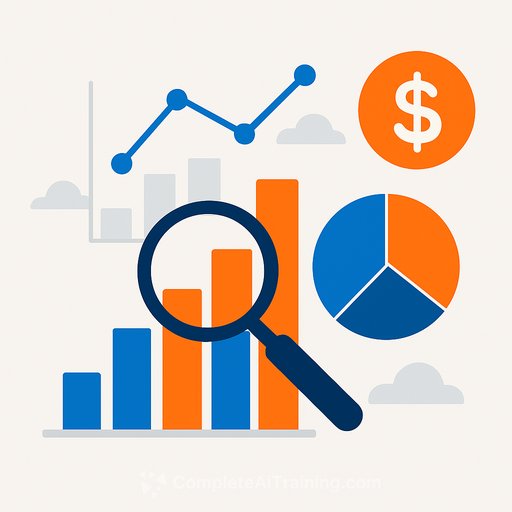Is the AI Economy a Bubble? What Finance Pros Should Watch Now
The AI trade is priced for perfection. Valuations are screaming higher while revenues lag. Chip and data center spending is immense, and there's growing worry about circular deals that make numbers look better than they are.
Economist Jared Bernstein believes we're in bubble territory. He doesn't say AI won't matter; he says the cash flows aren't keeping pace with the narrative. That gap is where investors get burned.
Why this looks like a bubble (by the numbers)
- $20+ trillion in market cap is concentrated in the "Mag 7." Price-to-earnings multiples are stretched by historical standards. A quick refresher on P/E math can be sobering.
- Spending outruns sales. OpenAI has talked about investing up to $1 trillion with revenue around $15 billion. Across Microsoft, Amazon, Google, and Meta, estimated 2025 AI capex plus R&D runs ~$70-100 billion per company. Reported AI revenue: Microsoft ~$15 billion; Meta ~<$1 billion.
- Cash cushions are thinner. Among hyperscalers, cash-to-asset ratios fell from ~29% (end-2021) to ~15% (mid-year). More buildout is now funded with debt, including opaque private credit.
- Circular financing risk. Example: a chip supplier invests in a model company that then buys more chips from the supplier. Looks good on paper, but outside demand may be weaker than it appears.
- Monetization is early. Consumer usage is high; revenue per user is low. Enterprise deployment is still near the early innings. The gap between hype and paid adoption remains wide.
Why it might not end like 2008
The largest AI backers are hugely profitable with diversified cash flows. Even if AI bets disappoint, the companies won't vanish. But segments of their valuation tied to AI could deflate sharply-similar to the dot-com era, where the tech selloff hurt, yet the internet still changed business forever.
The 12-24 month watchlist
- AI revenue vs. AI spend: Track capex+R&D divided by identifiable AI revenue. The ratio should fall fast. If it doesn't, that's a warning.
- Enterprise adoption: Watch paid deployments, not pilots. Look for >25-30% usage in core workflows with measurable output gains.
- Unit economics: Gross margin impact from AI products, inference cost per user, ARPU/seat trends, and churn after trials.
- Power constraints: Data centers meet electricity. Prices are rising ~7% year over year in some regions, which pressures margins.
- Balance sheet quality: Cash-to-assets, debt mix, and reliance on private credit. Opacity increases downside risk.
- Market breadth: The S&P "493" is up modestly versus the "7." Persistent narrow leadership is a classic late-cycle signal.
- Policy friction: Tariffs pass through ~50-60 cents on the dollar and could add about 1 percentage point to inflation near term-raising funding costs.
Investor playbook
- Separate core vs. AI optionality. Underwrite base business cash flows independently. Don't pay full value today for profits that may arrive in 2030.
- Demand disclosure. Push for segmented AI revenue, backlog, and committed spend. If you can't model it, don't overpay for it.
- Position sizing beats bravado. Size exposure so you can be early without getting forced out by volatility.
- Favor contracts over clicks. Picks-and-shovels with contracted revenue (power, networking, proven chips, thermal, grid services) beat vanity use cases.
- Stress test valuations. What IRR do you get if AI margins are 10 points lower or adoption is 2 years late?
- Hedge concentration. If your book rides on seven tickers, use index overlays or reduce single-name risk.
Operator checklist (CFOs and corp dev)
- Gate spend with signed revenue. Tie compute capex to contracted pilots with conversion SLAs and payback < 18 months.
- Kill vanity pilots fast. Track time saved, error rates, and incremental revenue per seat. If there's no lift in 60-90 days, stop.
- Vendor commitments. Avoid take-or-pay chip deals without usage flexibility. Don't let circular spend mask weak demand.
- Energy plan. Secure power capacity and pricing before you build. Electricity is now a line item that can break the model.
- Data advantage or bust. If you don't have proprietary data or distribution, your moat is thin. Adjust ambitions accordingly.
If you're assessing practical AI tools that already move numbers in finance, this vetted list can help: AI tools for finance.
If the bubble pops, who gets hit?
Equity losses land first on the top decile, which owns roughly 90% of the market by value. They can usually wait it out. The bigger risk is a spillover into hiring and a cyclical downturn-that hits lower-income workers harder through job losses and thinner buffers.
The good news: today's risk looks less systemic than 2008's mortgage stack. The bad news: a sharp repricing can still chill capex and push unemployment higher.
Policy notes worth tracking
- Guardrails matter. Capital buffers and oversight (think Dodd-Frank) help contain damage when speculation unwinds.
- Watch private credit. If AI buildouts lean more on opaque financing, monitor counterparty exposure and maturity walls.
- Tariffs and inflation. Higher pass-through keeps rates restrictive, raises hurdle rates, and slows risky projects.
Energy is the new bottleneck
AI's growth rides on electricity. Curtailing incentives for renewables hands an edge to countries scaling cheaper storage and generation. Battery tech is pivotal for reliability and cost. If the U.S. underbuilds capacity, inference costs stay high and margins suffer-while competitors catch up or pass by.
Bottom line
The tell isn't headlines-it's cash flow. If AI revenues compound fast enough to close the spend gap, the market can grow into its premium. If not, the AI slice of today's valuations gets marked down.
As a finance pro, your edge is simple: insist on unit economics, push for clarity, size positions with humility, and be ready to buy quality when the air comes out.
Your membership also unlocks:





